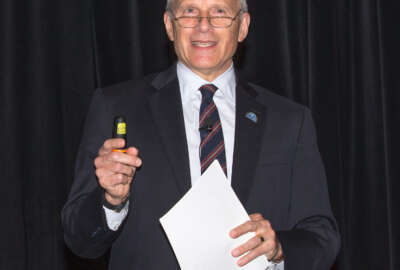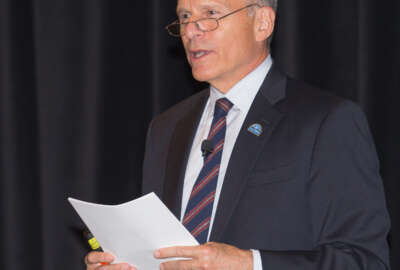

Starbucks calls its employees "partners." Disney has "cast members." The Ritz-Carlton has "ladies and gentlemen." The VA's new Chief Veterans Experience Officer...
Starbucks calls its employees “partners.” Disney has “cast members,” not staff. The Ritz-Carlton’s motto is, “We are Ladies and Gentlemen serving Ladies and Gentlemen.”
Maybe the Veterans Affairs Department should re-brand its workers too. Following a year of scandals and congressional scrutiny, the department is trying to get veterans, lawmakers and the American public to trust it again. As part of its strategy, it has hired its first chief veterans experience officer, Tom Allin. He said the VA is studying retailers’ secrets to improve its own customer service.
The first secret: If you want satisfied customers, focus on your employees.
The name matters a lot, Allin said. Consider the famed hospital Cleveland Clinic, where even those who schedule appointments are known as “caregivers.”
“If I’m a scheduler, a customer is an interruption. If I’m a caregiver, the customer is whom I’m here for,” he said. “The focus on the employees is clearly the biggest thing we have to do.”
Allin is one of several new VA leaders who owe their jobs to the scandal that engulfed the department last year. VA outraged the nation when it was discovered that veterans had been waiting weeks for critical medical appointments, while VA staff manipulated records to hide the delays. At the time, Allin was about to retire after a long career in the restaurant industry. But then he saw the new VA Secretary, Bob McDonald, vow to give veterans the service they deserved but had not received.
Allin was so moved that he sent McDonald his resume. McDonald called him soon after.
“I said, ‘Give me the hardest thing that you’ve got and let me help you,'” Allin said. “I could complete his sentences. Everything he was talking about was starting with the customer, which was my background.”
But Allin said he did not fully grasp the enormity of his task.
“I had no clue in terms of what that meant, in terms of a veterans experience office and how you work with these massive administrations,” he said.



The government’s largest civilian agency is divided into silos. The Veterans Health Administration, with more than 300,000 employees, is the nation’s largest health care system. But there’s also the Veterans Benefits Administration, which handles veterans’ claims for benefits, and the smaller National Cemetery Administration, which arranges burials. The VA hired Allin to improve customer service across the board.
Nine months after joining the VA, Allin has a better understanding of just how hard the job is. He said he spent his first few months examining veterans’ needs before realizing that he should be looking inward. Employee morale at the VA was in the dumps. It ranked second to last among big agencies in last year’s Best Places to Work list. Congress passed a law to make it easier to fire VA’s senior executives. New legislation would extend that provision to the VA’s entire workforce. As a sign of how fractured the department has become, a labor union representative recently gave McDonald a “hit list” of managers to investigate for mismanagement and wrongdoing.
And yet, Allin said, VA employees must have “the courage of common sense.” They should feel comfortable taking risks when it will help veterans. He said he wants everyone to share the blame for mistakes rather than point fingers. Every VA employee should be a team member.
When Allin arrived at the VA in January, he said everyone told him they wanted to make veterans happy. But no one knew exactly what that meant.
“At the VA, there’s a tendency sometimes too quickly to jump on ‘how’ before we define the ‘what,'” Allin said in a speech earlier this month to the industry-government group ACT-IAC. “Let’s start with what is it we are trying to accomplish before we decide what to do.”
After months of research, the VA has settled on three seemingly modest goals: to be predictable, consistent and easy to use.
“We’re not accomplishing any of those three right now,” Allin said. “I’d love to reach a point where we’re achieving delight, but let’s start with predictable, consistent and easy.”
Companies understand that they have to set customers’ expectations, then work to meet or exceed them every time, Allin said. Customer service at the VA can best be described as a crapshoot.
“Right now, we have extraordinary service in VA, sometimes, some places,” Allin said.
The National Cemetery Administration regularly beats public and private-sector organizations in the American Customer Satisfaction Index, a national survey. The health system is a pioneer in telemedicine, prosthetics and other services especially important to veterans. But elsewhere, the VA can feel like a black box. Staff encounters are rare. Aswers remain elusive.
Sometimes, the treatment defies common sense. The Seattle VA hospital told a veteran in its parking lot to call 911 because he could not walk to the emergency room. Staff at the Lakeland, Florida facility refused to get chairs for World War II-era veterans when the waiting room filled up. Allin’s office is looking at both situations.
“It’s like the 13 gates of hell sometimes for our poor veterans to come in and be able to use VA,” said Allin. “The experience once they’re inside the gates is good. I think we can do a better job of making it easier to become customers.”
Now that it has defined customer service at the VA, the Veterans Experience Office is trying to improve data collection and consolidate its digital services. It will bring its 1,000-plus websites under one portal, called vets.gov, in November. It has a similar plan to unify its call centers and its databases of veteran-customers.
Allin is still hiring staff. Coming from the corporate world, he said he was surprised to discover how long it took to fill vacancies in the federal government.
But once fully staffed, the Veterans Experience Office will include five field offices in addition to its Washington headquarters. The field staff will act as consultants, swooping into local facilities that need help meeting their customers’ needs. It will help those facilities collect better data, both from their customers and their employees.
That’s important, Allin said, because while Washington can set standards and expectations, progress will happen facility by facility.
“It will be the employees in that facility deciding, ‘We’re going to be the best. We’re going to achieve this. This is our facility. This is our family, our customers, our veterans.'” he said.
In its drive to offer predictability, consistency and ease across the department, the VA does not want to handcuff its employees with more rules and regulations, he said.
“It’s the emotional piece that you’re trying to get from the employees,” he said. “You want the personality of the employee to come through so they’re able to be themselves and develop a relationship with a customer. You don’t want robots.”
A philosophy of “goals and guardrails” helped him lead in the restaurant industry, Allin said.
“I give you the goals and get out of the way. But if you hit the guardrails, then let’s talk,” he said.
That’s more challenging in a government organization that has had so many missteps. McDonald routinely faces criticism for not firing more employees responsible for the patient care scandal.
“I don’t think firing is the problem,” Allin said. “My goal is not the accountability. It’s allowing people to take risks and get something done.”
Copyright © 2024 Federal News Network. All rights reserved. This website is not intended for users located within the European Economic Area.
